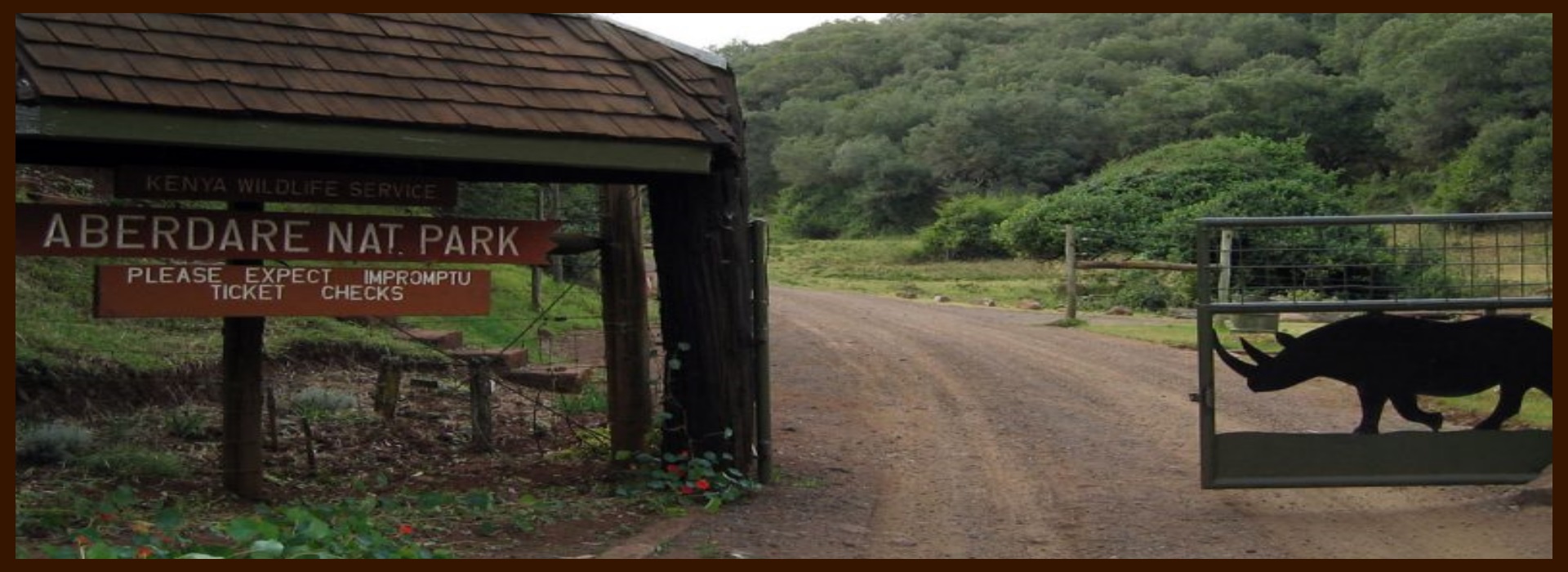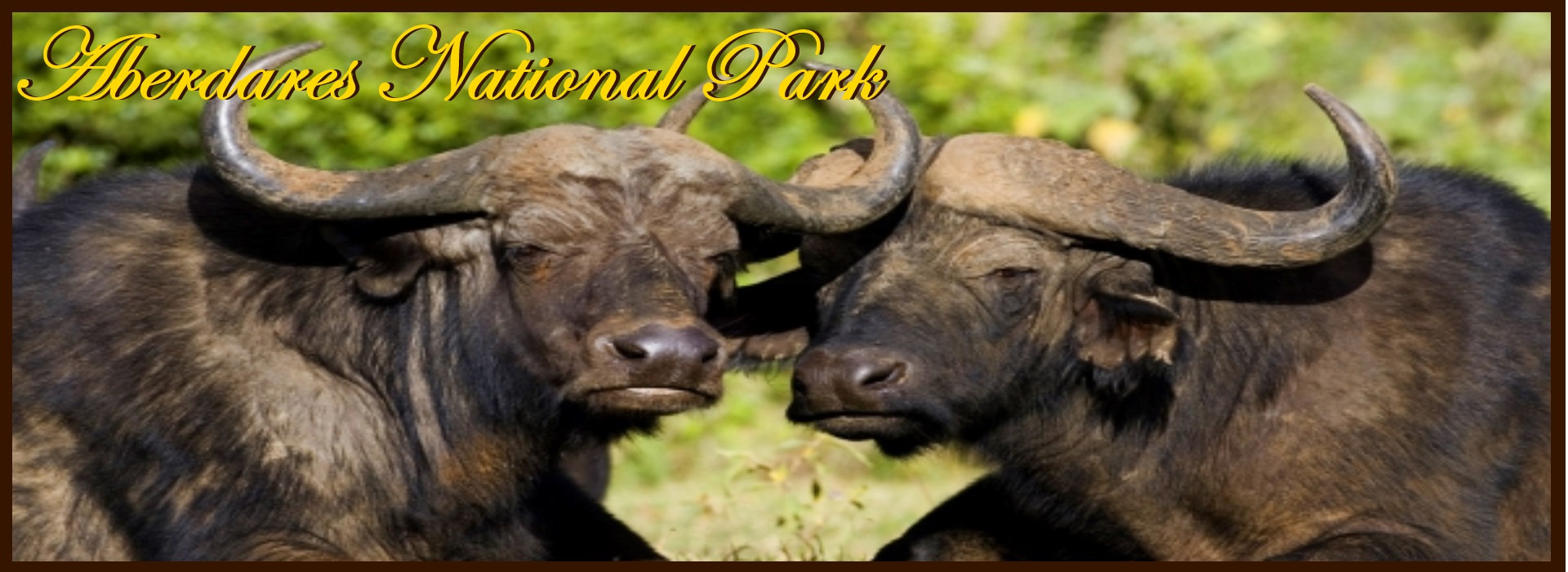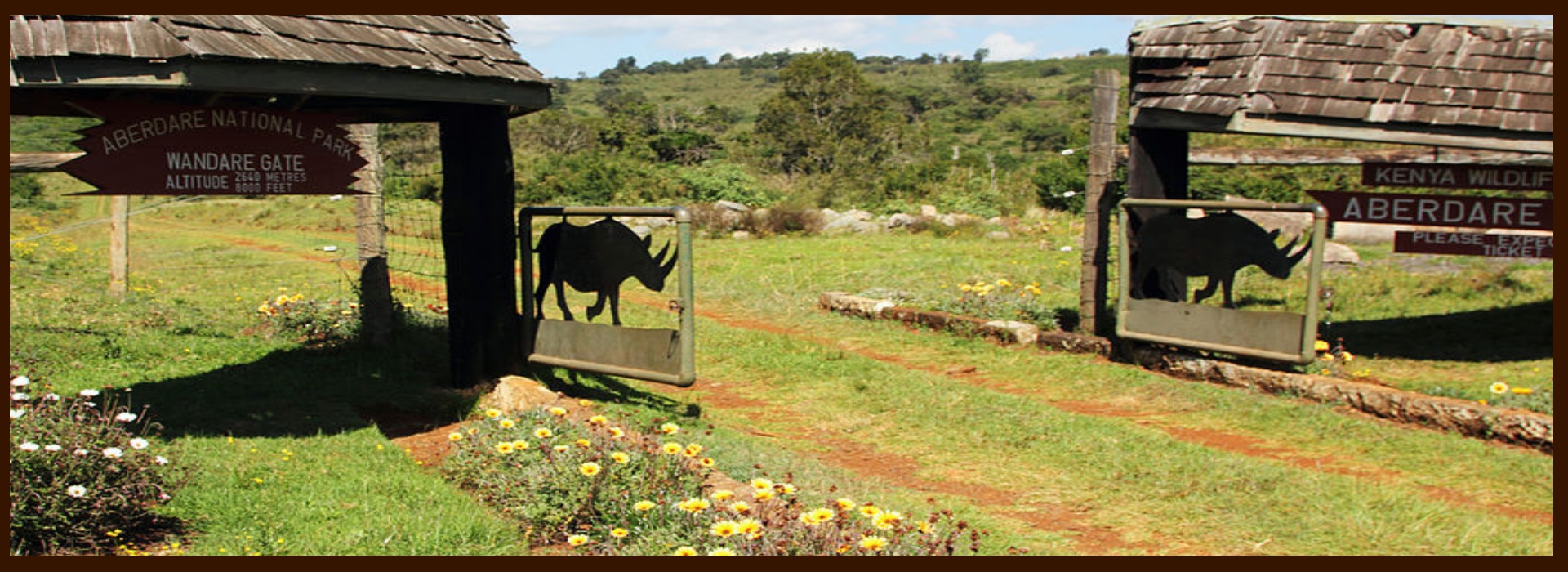Aberdare National Park – Kenya
Area: 767 Km Sq. Altitude 1,829 – 4, 001 meters above sea level.
Location: 180 km from Nairobi, in the central highlands west of Mt. Kenya.
Climate
Cool and misty. Year round rains average one thousand (1,000 mm) on the drier northwestern slopes and upto three thousand (3,000 mm) in the southwest.
Open: Daily 6:00 am to 7:00 pm. No entry after 6:15 pm. No entry allowed on foot. Walking and hiking only allowed in designated areas only and in the company of a KWS ranger. Contact your tour operator for specific information.
When To Go
The Aberdare National Park is open all year round.
Natural World Kenya Safaris cover the Aberdare National Park in some of its safari programs.
Majestic, moorlands, peaks and falls
Beautiful wild moorlands, encircling Kenya’s third highest mountain range, nestle this misty realm where elephants roam through lichen-hung forests as spectacular waterfalls plunge into churning pools, cascading into trout-filled streams amidst mossy dells.
A haven for anglers, walkers and lovers of solitude.
Exhale as you savour the unspoiled glories of the Aberdare range, unwind in some of Kenya’s most famous lodges and absorb the breathtaking vistas of Mount Kenya’s glittering coronet, sorrounded by the sparkling lakes of the great rift valley.
Peaks and moorland
The 70 km long Aberdare range is a narrow massif streching from north to south with it’s southern end just 80 km north of Nairobi.
The moorland comprise undulating hills, bogs, clear mountain streams,
numerous waterfalls and magnificient views occuring between the highest peaks of the Aberdare mountain range: Oldonyo Lesatima (4,001 m) to the north and II Kinangop (3,906 m) to the south. Other notable peaks are Chebuswa (3,364 m), Table Mountain (3,791 m) , Rurimeria (3,860 m), Maratini (3,698 m) and the Elephant Hill (3,590 m).
Spectacular waterfalls
The Aberdare National park is renowned for it’s torrential waterfalls plunging from cloud-shrouded heights to spray-filled ravines. Gura waterfall, which cascades 300 m into an impenetrable ravine, is the most precipitious fall in Kenya while Karura Falls is the longest (273 m), occuring in three steps of 117 m, 26 m, and 130 m. Chania Falls, Maragua Falls and Queens Cave are also popular sites.
Mountain climbing, hiking and walking
You don’t have to be a mountaineer to climb Aberdares peaks; most can be conqured by a vigorous high-altitude walk.
There are countless panoramic moorlands hikes and shady forest walks to be enjoyed.
Excellent mountain stream fishing
Brown and rainbow trout abound in cool mountain streams and provide excellent angling.
A sports fishing license can be obtained at the Aberdare National Park gates upon entry.
Wildlife
Among the 2,000 elephant that roam the clouded hills and misty glades, are the few remaining habitats of the exclusive rare Bongo antelope and the rare giant forest hog.
Black rhinos are also present in the park.
Amidst forst and moorlands, large herds of Cape buffalo browse, w
hile the forest depths provide sanctuary for the dainty blue duiker and bushbuck as primate troops of colobus, sykes and the black-faced vervet rustle through the trees and lush stands of bamboo.
Sombre olive baboon patrol the forest and grasslands, fearfully avoiding leopards.
Other carnivores are the African wild cat , spotted hyena, African civet and the rare golden cat.
More often heard than seen are lion which were introduced to the park some yars ago.
Also rarely seen are serval cats, with many being melanistic (black) due to their adaptation to this higher altitude. Tumbling mountain steams are home to the African clawless otter, who compete with anglers in pursuit of brown and rainbow trout.
Birds
Abundant Aberdare birdlife greets most dawns as a chorus of birdsong pours out of the forests.
Over 290 species have been recorded including the Aberdare cisticola that is critically endangered amd the Jackson’s francolin which is regionally endemic.
Often encountered are the bold silvery-cheeked hornbill with their raucous cry casqued beaks, as well as the sacrlet-winged falsh of the Hartlaubs’s turaco.
Plentiful birds of prey include augur buzzard, African goshawk, hawk eagle and the magnificient African crown eagle which prey on monkey, francolin and guinea fowls.
Within forest glades are the cinammon-chested bee eater and Africa paradise fly catcher while the bamboo glades or higher moorlands are the domain of numerous species.
Plants
The forest of the Aberdare range are globally renowned for their botanical richness. At varying altitudes are a wealth of flora: from the top while descending, alpine and sub-alpine species such as senecio lobelia, erica helichrysum and tussock grass give way to bamboo and mountain woodlands , mainly junipers podocarpus and nuxia congesta forest on the western and northwestern slopes. Ocotea forest are found in the southeast and mixed podocarpus forest on the east and on Kipipiri. Pockets of hegenia forest also occur in sheltered patches on the rolling moorlands.
Insects
The Aberdare National park vegeation shelters more insects than any oher living creature!
Common around most forest lodges are large, noisy carpenter bees while both forest and moorlands are exceptionally richj in butterfly such as the striking large swallowtails and the endemic highland forest blue charaxes. Other charaxes species include the forest king charaxes, the white bird charaxes and the black bordered charaxes while the lively little painted ringlets is restricted to the bamboo zone.
Reptiles
The Aberdare forest are home to a large number of snakes, frogs and lizards.
Snakes of interest feature the montane egg eater, a slender bird egg lover, the Kenya stripped skaapsteker, a resident of the high grasslands of the Kinangop plateau and the endemic Kenya montane viper, found at high altitude areas of the Aberdare and Mt. Kenya.
The broad array of lizards includes the stripped skink, the alpine meadow skink, the variable skink and the grass top skink which can often be seen wrigling through tuossock grass clamps.
How to get there.
The park is 180 kms north of Nairobi.
Your Kenya safari tour operator will organize transport and game viewing drives at the Aberdare National park.
Roads
The salient portion of the Aberdare National park has a good road network but over tough terrain more suitable for 4WD vehicles.
The rest of the park is mainly traversed by gravel and dirt roads with 4WD recommended.






